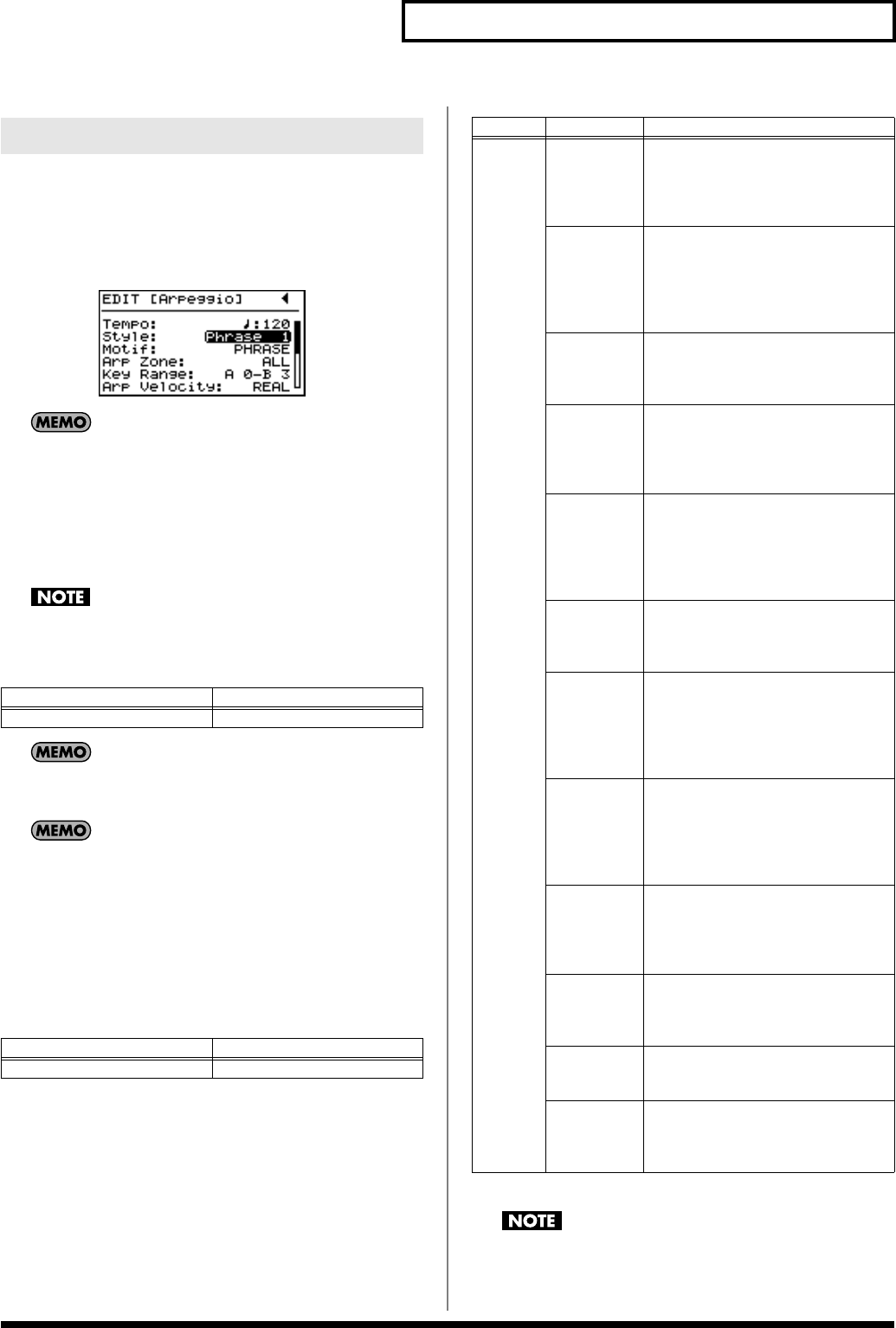
95
Detailed Settings for Each Function ([EDIT])
The function that allows you to perform arpeggios (chords whose
notes are played sequentially rather than together) from a chord’s
constituent notes, just by playing the chord, is called “Arpeggiator.”
You can make more detailed arpeggio settings, including tempo and
range.
fig.05-24g
For more on switching the Arpeggiator on and off, refer to
“Playing Arpeggios ([ARPEGGIO])”
(p. 46).
Adjusting the Tempo
(Arpeggio Tempo)
This sets the speed of the arpeggio.
The RD-700SX has one tempo setting. You can change this
setting in the tempo display in the Tone screen; or alternatively,
you can change the rhythm’s tempo setting (p. 49).
The way Arpeggio is played and the tempo display may differ
with some Arpeggio Styles.
With Clock Source (p. 81) set to MIDI, “M:” appears in the
display, and the RD-700SX is synchronized to the tempo of the
external MIDI device. The tempo cannot be changed with the
RD-700SX when “M:” is indicated.
Setting the Way Arpeggios are Played
(Arpeggio Style)
This sets the style of the arpeggio.
Changing the Order in Which Notes
Are Played (Arpeggio Motif)
Set the order to play the notes for the keys pressed from the
following.
Depending on the Arpeggio Style selected, it is not so effective
as it expected.
Making Arpeggio Settings
Parameter
Value
Tempo
10–250
Parameter
Value
Style
“Arpeggio Style List”
(p. 152)
Param
Value Description
Motif
UP (L) The notes are played one by one in
sequence from the lowest of the
pressed keys.
The note for the lowest pressed key is
sounded each time.
UP (L&H) The notes are played one by one in
sequence from the lowest of the
pressed keys.
The notes for both the lowest and
highest pressed keys are sounded each
time.
UP (_) The notes are played one by one in
sequence from the lowest of the
pressed keys. No one note is played
every time.
DOWN (L) The notes are played one by one in
sequence from the highest of the
pressed keys.
The note for the lowest pressed key is
sounded each time.
DOWN
(L&H)
The notes are played one by one in
sequence from the highest of the
pressed keys.
The notes for both the lowest and
highest pressed keys are sounded each
time.
DOWN (_) The notes are played one by one in
sequence from the highest of the
pressed keys. No one note is played
every time.
UP&DOWN
(L)
The notes are played one by one in
sequence from the lowest of the
pressed keys to the highest, and then
back again in the reverse order.
The note for the lowest pressed key is
sounded each time.
UP&DOWN
(L&H)
The notes are played one by one in
sequence from the lowest of the
pressed keys to the highest, and then
back again in the reverse order.
The notes for the lowest and highest
pressed keys are sounded each time.
UP&DOWN
(_)
The notes are played one by one in
sequence from the lowest of the
pressed keys to the highest, and then
back again in the reverse order.
No one note is played every time.
RANDOM
(L)
The notes are played one by one in
random order.
The note for the lowest pressed key is
sounded each time.
RANDOM
(_)
The notes are played one by one in
random order.
No one note is played every time.
PHRASE A phrase based on the pitch of the
lowest pressed key is played. If more
than one key is pressed, the pitch of
the key that is pressed last is used.
RD-700SX_e.book 95 ページ 2006年3月23日 木曜日 午後2時52分


















